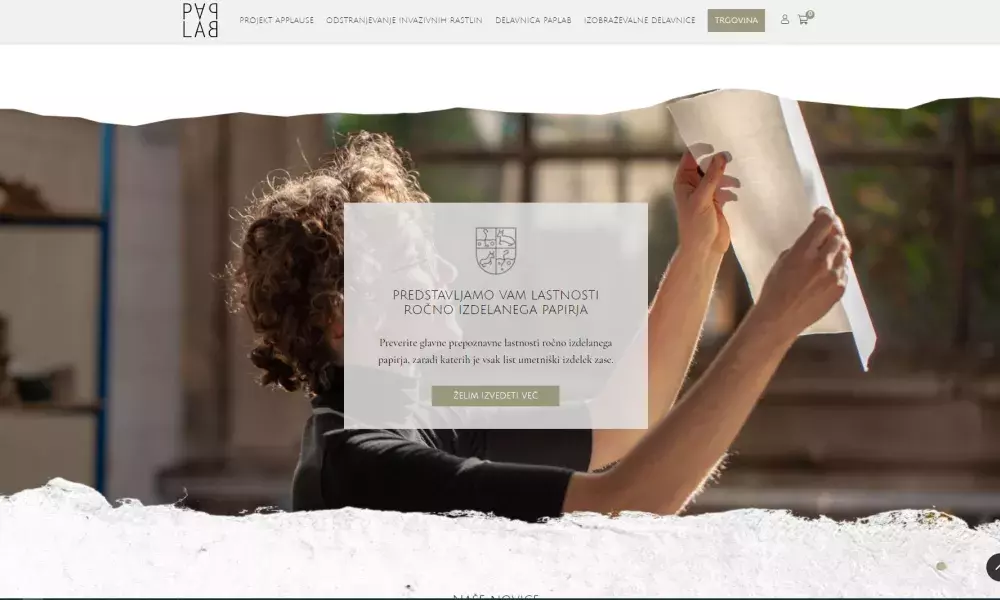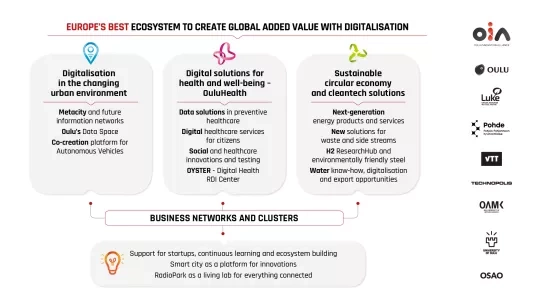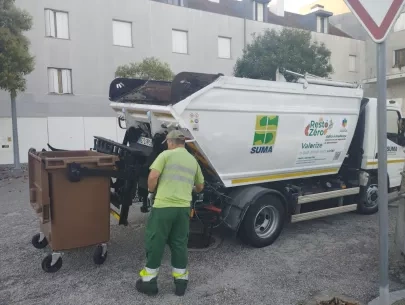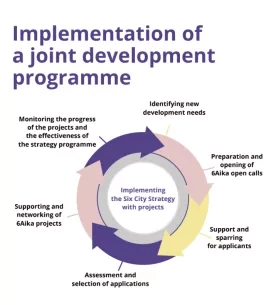Ljubljana Journal 6: A recap of what has happened since the project officially finished in December 2020

1. Executive summary
APPLAUSE officially finished in December 2020 after 3 years of implementation. During 2021, the consortium has put in place its long-term sustainability strategy which is based on the different circular business models that were developed for IAPS-based products and workshop activities. To do so, it has relied on its collaborative supply chain which starts with plant identification and biomass harvest and follows the different production steps until the products and services are on the market.
Among the most successful business-led activities that are continuing after the project end date, there are the website paplab.si (by VOKA-SNAGA) with its online store for IAPS wood and paper products, the organisation of a summer school at the creative laboratory Krater (by TRAJNA), or the production of new packaging made of Japanese Knotweed (by the Paper and Pulp Institute). Research partners have also continued to use the project results in new scientific projects. During all this time, the City of Ljubljana continues to support partners and acts as an ambassador for the different business models and initiatives.
During the 3 years of implementation, APPLAUSE has generated a wealth of knowledge on how to manage IAPS in a more circular way. This includes a deep knowledge of the presence of IAPS in its territory, the different species’ properties and potential uses, optimal ways for processing the biomass, or the market potential for new products and services. Among the main lessons learned, this journal focuses on 3 main aspects. Firstly, the need for true cooperation in complex circular models. Secondly, the capacity shown by the consortium to adapt to changing circumstances, mainly the COVID-19 pandemic. And finally, the importance of technology in the delivery of public services. This journal includes several recommendations to other local authorities wishing to develop a similar initiative. A more complete guide on lessons learned and the Project playbook have been produced by the consortium.
APPLAUSE has proved that a circular management of IAPS can deliver more value to the environment, society, and the economy. However, implementing such a new system is not easy. The project’s integrated approach and its focus, since the very beginning, on long-term sustainability have been key elements for its success. But the legacy of APPLAUSE goes beyond this. APPLAUSE is a shining example of how to apply circular thinking and business modelling approaches in public service delivery. Also, its participatory model that offers citizens different choices on how and when to engage is highly replicable not only in other public campaigns but by other cities wishing to increase the level of participation of citizens in local initiatives.
2. Project's progress
APPLAUSE officially finished in December 2020, after a disruptive last year when many activities had to be rethought and adapted to the conditions of the COVID-19 pandemic. Prior to the project closure, the consortium held many discussions on the interests and capacities of partners to continue collaborating in the IAPS-based circular business models. The results of such discussions are summarised below.
With the support of its leadership, the team of VOKA-SNAGA (the water and waste management public company of the city of Ljubljana) has continued developing its business model for the IAPS handmade paper products. Through the website paplab.si, VOKA-SNAGA has already sold several handmade paper products, the most popular one being the sieve and the frame for making paper. The website, whose content is promoted via social media, is a great tool to continue disseminating information about IAPS and how these can be turned into useful circular products. Recently, the APPLAUSE products have caught the eye of the art market segment, mainly calligraphers and photographers, who are attracted by the unique story of sustainability behind APPLAUSE products. This was a market segment not yet explored during the APPLAUSE project.
While pursuing this business venture, VOKA-SNAGA has also continued to operationalise the circular model, taking care of the IAPS removal, their treatment and the management of the collection points, together with its subcontractor TISA. The PAPLAB (handmade paper) workshop is closed to the public temporarily due to the ongoing COVID-19 crisis, but educational activities for schools should resume as soon as restrictions are lifted. As for the woodworking workshop, it is currently being used for the maintenance of public furniture, although there are plans to turn it into a handcraft workshop for local artisans and students once the COVID-19 pandemic is over.
VOKA-SNAGA is not the only partner that has been busy during the past months. The NGO TRAJNA has organised a summer school at its creative laboratory Krater combined with some activities outdoors. The Pulp and Paper Institute (ICP) continues to produce paper made of Japanese knotweed. Customers that have shown interest in the IAPS paper include a printing shop (https://papirusprint.si/), an exhibition space (https://dobravaga.si/), a plant shop (https://dzungla-plants.com/), the Ministry of the Environment or the NGO Food for Life (https://ffl.si/). They have also designed new packaging made of IAPS for a local kitchenware company (https://kuhina.si). Also, the Institute and letterpress studio tipoRenesansa (TIPO) has produced some IAPS-based gadgets for the Slovenian Environmental Agency and has shipped a set of IAPS-based wood types to the Northeastern Illinois University in the US.
Finally, APPLAUSE research partners have harnessed the ample knowledge generated during the project to continue publishing papers and participating in international conferences. The work of several Ph.D. students is still ongoing and the University of Ljubljana has included the heritage wood type letterpress technique in its curricula. Also, SPACE-SI is working on one of the first Slovenian microsatellites (Nemo-HD) to automatically detect IAPS, along with other applications for agriculture, forestry, urban and maritime purposes, using the algorithms developed in APPLAUSE.
As shown above, many activities developed by APPLAUSE have not stopped once the project is finished. This has been possible thanks to the liaison of the City of Ljubljana who, as project lead, has encouraged partners to think beyond the project duration and engage in strategic alliances. The city still plays a crucial role as an ambassador of APPLAUSE activities, connecting these partners with other stakeholders interested in IAPS-based products and activities.
Since the very beginning, the ambition of APPLAUSE has been to make the circular approach for the management of IAPS self-sustainable. The means for reaching such sustainability are the different circular business models (paper products, wood products, workshop activities…) and their collaborative supply chain which starts with plant identification and biomass harvest and follows the different production steps until the products and services are on the market.
The project does not have one single long-term sustainability, its approach has been rather flexible and adapts to the interests and capacities of different partners. Back in September 2019, the group of partners involved in the circular model participated in a workshop that aimed to: identify the key goals and activities to be fulfilled as part of the future business models; to think about what skills and experience each of them could bring; to analyse the situation (SWOT); and jointly develop an action plan. The initial plans had to be adapted in 2020 when the COVID-19 pandemic disrupted the entire world, changing the market conditions and banning the organisation of public events, such as workshop activities. Now, in September 2021, the project’s plan for long-term sustainability relies on the following:
- VOKA-SNAGA will continue supporting the new circular business models for at least 5 years. The APPLAUSE team has developed a thorough strategic and financial plan that has allowed the leadership to take such commitment. For the handmade paper-making workshop, the plan is to continue positioning its products into the domestic market with the projection to reach break-even in 5 years. For the wood workshop, the current model is already self-sufficient thanks to the provision of repair and maintenance services to the City of Ljubljana (e.g. for public benches, fences, etc.). In the longer-term, the aim is to increase the sales of wood products and open the workshop to potential customers (artisans, students) who will make use of the equipment in exchange for a service fee.
- ICP is taking a commercial approach and expects to continue producing paper made of Japanese knotweed for local customers who have already shown an interest.
- TRAJNA is currently looking for new projects that can help co-finance the Krater workshop. One example has been the organisation of a summer school together with one of the APPLAUSE's partners, Jozef Stefan Institute. Besides, TRANJA has managed to attract other local NGOs interested in getting involved with the Krater workshop.
- As for TIPO, the owner expects to continue organising IAPS-focused activities together with its network of volunteers as an ancillary activity that complements its ongoing business at the letter printing and calligraphy studio.
Partners are still fine-tuning the different business models and have recently held discussions to overcome some challenges such as the shortage in wood supply, the price of the biomass or future COVID-19 waves. Nevertheless, the foundations of the different business models are there, and all of them remain optimistic about their future developments.
3. Generated knowledge
In the last months of APPLAUSE, the consortium published a brochure on lessons learned and the Project playbook, which summarise the generated knowledge and the main aspects to take into account if another local authority wishes to develop its own circular model for the management of IAPS. Out of these, I would like to focus on the following aspects:
Cooperation
One of the most important lessons learned, and a central aspect of the project, has been the need for genuine cooperation. Compared to linear models (take-make-use-dispose), circular models with their multiple loops to recover and reuse materials are more complex by nature. All partners involved must cooperate to cut through this complexity and achieve optimal results, from an environmental, social and economic perspective. In the case of APPLAUSE, its circular model for the management of IAPS follows 6 steps: plant identification, biomass harvesting, processing & storage, value recovery, final production, and the launch of the products and services to the market. All these steps are divided into smaller sub-processes which vary as well depending on the type of IAPS to be recovered (out of the 25 selected) and the products to be developed (paper, wood, dyes, organic pesticides…). The partners involved in each of these steps are very different, from the botanists and green area managers involved in the first stages, to the creative people responsible for designing the prototypes or the business specialists who assess the product-market fit. Such diversity was a challenge at the beginning and learning to work together took some time.
The leadership showed by the City of Ljubljana at all times was crucial for its success. The team in Ljubljana was composed of people from different departments (environment, EU funds, IT, communications…). Working across departments is part of the City of Ljubljana’s DNA. And such organisational arrangement within the urban authority was successfully replicated at consortium level. In practical terms, it translated into monthly meetings and regular reporting of the achieved milestones. This helped partners, especially those with smaller roles, to stay connected to the project. Also, the City of Ljubljana had enough dedicated staff (2 full-time and 5 part-time employees) to assist, motivate and inspire the other partners at all times. This was particularly important during the COVID-19 first wave when many partners had to rethink and adapt their activities to the pandemic measures. The team in Ljubljana also made an effort to support and educate other employees indirectly involved in the project, for example, the workers responsible for pruning and trimming the trees, so that they could also understand the value they brought to the project.
As a result of this cooperation, the consortium managed to develop a shared vision for the project, meaning that all partners “spoke the same language”. Now that the project is over, there is a sense of fulfillment among the partnership and a real willingness to continue collaborating in the new business models as well as in some events such as the annual IAPS festival.
Citizen’s engagement
The APPLAUSE project puts the citizen at the centre of the circular model. It has developed its own participatory model and encouraged citizens to engage at 3 levels (Do it Yourself - DIY, Let’s do it together or Handing over) depending on the interest and capacities of different audiences. For more information on APPLAUSE citizen engagement approach, please check the Zoom-in 2 report.
During the first two years, the project organised many activities with and for citizens, such as the harvesting campaigns or the hand-craft paper workshops, which were part of the “let’s do it together” level. The consortium soon realised that the hands-on workshops worked really well, especially with school children and the elderly. However, the organisation of voluntary harvesting campaigns was more challenging. These involved some physical work and sometimes the weather was not helping. For these, the groups that showed more interest were high schools and students from the Forestry department of the University, so halfway through the project, the APPLAUSE team decided to focus these campaigns on these target groups only.
One of the main lessons learned on citizen engagement has taken place during the COVID-19 pandemic. In March 2020, when planning the last round of “let’s do it together” activities, everything had to stop due to the pandemic. That’s when the “Do it yourself (DIY)” pillar took off. The rationale behind this pillar was to provide citizens with all the resources they needed to harvest and use IAPS without expert assistance. At the time, the consortium had already produced a DIY catalogue with instructions on how to make handcraft paper at home, build a wood birdhouse or prepare homemade formulations of organic pesticides using IAPS as raw material. They had also produced a few videos which are available on YouTube. Until then, the number of people using these resources was limited but the pandemic reversed this situation. Citizens had to stay at home and that’s when they went online looking for activities they could do. The success factors of APPLAUSE DIY resources were: their simplicity, they could be set up alone or with the family; they were fun, such as building a xylophone or cooking a recipe with Jerusalem artichoke; and helped to take care of the planet, by removing a harmful element such as IAPS and turn it into something useful. During 2020, the project invested a lot in the production and promotion of new DIY videos, some of them reaching more than 40,000 views on YouTube. The experience and successes with the DIY citizen engagement strategy can now be applied to other city campaigns. Also, the team has realised that while promoting APPLAUSE, they have managed to support citizens in remaining active while staying at home, improving their wellbeing, and empowering them to take action in difficult times.
The last level of citizen engagement, “handling over” encouraged citizens to bring the IAPS they harvested to collection points located in the city’s collection centres where they were correctly disposed of. This followed the more conventional approach to recycling which requires less involvement. Unfortunately, little quantities have been collected and not always were properly sorted. While collection points are easy to set up and require fewer resources to manage, APPLAUSE has demonstrated that citizens are more interested in active campaigns such as workshops or DIY.
Technologies, inventories and protocols
As a pilot project, APPLAUSE had the opportunity to test several methodologies for IAPS identification. These included traditional fieldwork as well as the application of new technologies such as Artificial Intelligence for plant recognition or the use of satellite imagery in combination with aerial photos for IAPS widespreadness analysis. The project has made considerable advances in the use of these technologies for IAPS management and some of the results obtained such as the algorithms for automatic IAPS detection are now being used in agriculture, forestry or maritime applications. Now that the project is over, it is difficult to continue developing and finetuning these technologies to serve the purposes of APPLAUSE. Nevertheless, one of the great gains of the project has been to develop a wealth of data on the presence of IAPS in Ljubljana. It was a huge investment to build such a complete inventory with 30,000 data entries for 121 plant species. However, a repository of data itself is not valuable unless it is used. APPLAUSE has developed a new digital platform where data is stored, maintained and analysed to support the work of green area managers in maintaining the inventory, arranging biomass collections and organising deliveries to those partners developing IAPS paper or wood products. To develop this platform, APPLAUSE partners spent the first year testing and optimising the processes for IAPS identification, harvesting, pre-processing and delivery (the protocol can be found in APPLAUSE Journal 1). Then these processes were designed into the online platform which provided access to the inventory and managed the orders of biomass. Before APPLAUSE, green area managers spent lots of time preparing the list of locations and eradication maps, now this is done in half the time and the work is organised through the online platform. This is a considerable improvement in the delivery of public services.
Any local authority wishing to implement a circular approach to IAPS management should consider the following aspects:
- Know your territory: Before starting with APPLAUSE, Ljubljana already had good knowledge of what species were present in its territory and where to find them. It is important to know if IAPS are abundant otherwise the circular model is unworkable since it is missing the principal element, the biomass.
- You will need careful selection, harvesting and processing: Not all IAPS can be processed and turned into a material that can then be used to develop products (paper, wood, dyes...). Ljubljana’s scientific partners spent quite a lot of time in the beginning analysing the mechanical and chemical properties of each species. Also, it is important to know when the right moment to harvest is (depending on the season, dry/wet conditions) and how to process the material and store it to keep the desired properties and textures.
- Bring in the local creatives: In APPLAUSE it has been very enriching to have local creatives leading on the development of the new wood and paper products. They have managed to develop attractive, functional, and unique products that capture the value of APPLAUSE.
- Business modelling is not straightforward: Since the beginning, APPLAUSE has aimed to create a circular model for the management of IAPS that is self-sustainable. It has achieved this by remaining lower-scale and local. But the process has not been easy. Circular business models are more complex than linear ones, and in the case of APPLAUSE, it requires the collaboration of many stakeholders. Also, business modelling is a very different approach to more traditional public service delivery. VOKA-SNAGA sought the help of experts to support certain tasks such as the market analysis or the commercialisation strategy. The systematic and thorough work of the team at VOKA-SNAGA and the City of Ljubljana combined with the support received from externals has been crucial to delivering a business model that makes sense for Ljubljana. However, in the case of circular economy, what works in one place may not work in another. It is important to adapt to the local circumstances. In the case of Ljubljana, the heritage of the city in paper-making and wood products smoothed the way for a business model based on these two elements, paper and wood.
- Education and public awareness are crucial: Finally, the problem posed by IAPS is largely unknown to the general public compared to other environmental topics such as climate change or air pollution. In APPLAUSE, the efforts dedicated to raising public awareness and educating citizens, in particular children and young people has been vital for its success. Also, APPLAUSE has shown that not everyone is prepared to engage in a topic in the same way, providing different options (DIY, public events, workshop activities) is a very smart approach to citizen engagement.
4. Conclusion
During these 3 years, I have been supporting APPLAUSE, I have always been amazed by the capacity and the enthusiasm of the team of the City of Ljubljana to lead this project. The city administration’s working style, collaboratively and open-minded, has been remarkable.
The aim of APPLAUSE was to turn something that is harmful (IAPS) into something useful (mainly the new circular products and workshop activities). This same rationale was applied when the COVID-19 pandemic broke into our lives, turning a problem (lockdown and social distancing rules) into an opportunity (promotion of DIY products and activities). Public administrations are not often characterised by their capacity to adapt. However, in APPLAUSE, the City of Ljubljana has proved the contrary.
In my view, one of the main strengths of APPLAUSE is its integrated approach. The aim of the project was to address the problems posed by IAPS through a new process based on the circular economy. However, in doing so, it not only addressed the three pillars of sustainability (environment, economy and social wellbeing) but incorporated a fourth one, culture. APPLAUSE has mobilised local creatives to incorporate circular economy into their activities. The result has been the revival of old craft traditions (handcraft paper-making and heritage wood type letter pressing) and the promotion of circular designs for paper and wood products that use IAPS as raw material.
Another key strength has been its focus on long-term sustainability. The project aimed to build a circular model for the management of IAPS that is self-sustainable over time. Such determination has guided the project throughout its lifespan and shaped the different actions developed, especially those related to the business models. The results of this can be appreciated in the number of activities that are still ongoing even if the project finished more than half a year ago. Also, many of the partners continue to work together. This proves their level of commitment and the value the project and its partnership brought to their organisations.
Finally, APPLAUSE has delivered two new solutions that constitute the legacy of the project. The first one is the new circular approach to the management of IAPS. This approach represents a completely new way of delivering public services, based on circularity and business modelling. The City of Ljubljana could now apply the same circular economy thinking and the experience gained in APPLAUSE to other public services.
The second one is its participatory model. Instead of a one-size-fits-all approach, APPLAUSE proposes three levels of engagement (the “Do it Yourself – DIY”, the “Let’s do it together” and the “Handing over”), giving citizens a choice on how and when to engage. Such an approach to citizen engagement is highly replicable in other initiatives led by the City of Ljubljana or by any other city wishing to develop more successful citizen engagement strategies.
About this resource
The Urban Innovative Actions (UIA) is a European Union initiative that provided funding to urban areas across Europe to test new and unproven solutions to urban challenges. The initiative had a total ERDF budget of €372 million for 2014-2020.
Similar content




